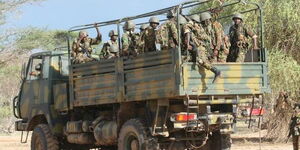I'm a huge safari enthusiast - to put it mildly. This is mostly because taking to the road, to places unknown, is an adventure; a true broadening of horizons; an education for the mind; and a rejuvenation of the soul.
I can't quite point out where my passion for the great outdoors began, but I'm pretty sure dad's ritual of having Nat Geo as the default channel had something to do with it.
Anyway, last year, for my birthday, I decided to treat myself by taking a trip to the land of my forefathers - Ukambani.
I would have taken bae along, but she opted out, going on and on about her wanting me to take in all my cultural heritage without her distractions - but between you and me, I think she was just scared of the heat. Don't tell her I said that.
So there I was, fully kitted out in brand new khakis, one of those Tembea Kenya T-shirts, my camera and a pair of binoculars in hand.
Yes, I carried plenty of water knowing I was heading to Ukambani - there, we are almost done with all the Ukambani jokes. But I'll throw in a voodoo joke later on, so be on the lookout - Now back to my trip.
Machakos
I was happy to watch Nairobi disappear from my rearview mirror as I cruised along Mombasa Road towards my first destination, Machakos.
I have nothing against the capital, but any chance I get to leave all that traffic, honking and the occasional run-in with the police behind, is a chance I welcome with open arms.
Which is why I was smiling from ear to ear when I saw the huge 'Welcome to Machakos County' billboard.
It had taken me an hour and a half - mostly due to the crazy Nairobi traffic I mentioned earlier on.
Anyway, I was finally here. Back where it all started for me and my kin, a century or so ago - or, in the least, according to recorded history.
I couldn't help but imagine what must have been running through the mind of the locals when the British established their first-ever upcountry administrative centre back in 1889.
Kyamwilu Hill
These were the questions burning through my mind as I made my way to a famous hill, lured by countless tales of its wonder. I'm talking about Kyamwilu Hill, where the laws of gravity take a backseat, or so I heard.
Thanks to uncle Google, I discovered a route so scenic, it looked like a painting straight out of Van Gogh's collections.
I opted for this route that ran right along the Mua Hills. Here, terraced slopes, lush green maize fields and views out to Lukenya to the west, and Machakos to the east, make for a breathtaking drive.
Tales are one thing, but seeing a 10-tonne truck slowly roll uphill with its transmission in neutral mode is something else.
Unconvinced and partly thinking this was some sort of local voodoo - that's the last stereotypical Kamba joke I promise - I placed my own bottle of water on the tarmacked road and watched in amazement as it made its way uphill!
This was too much for me and it was all I thought as I made my way downhill to Machakos Town or was it uphill.
I made a quick stop at the T.Tot hotel whose samosas were the stuff of legend - or at least that's what bae told me despite her never having set foot in Ukambani.
However, I'm happy to report that the rumors were quite true, for once.
Kitui
It was about midday and I was now ready to embark on the second phase of my road trip, with the actual town where my father was born, and his father before him, and his...you catch my drift. Kitui.
I did make another quick stop in Wamunyu - a town famous for its wood sculptors, and their carvings are even better than advertised.
It took me about an hour or so to get to Kitui Town and what immediately stood out for me was a humongous rock that simply refused to disappear from view as I drove into town.
As it turns out, this is Nzambani rock. The name may not ring a bell to most, but its story is well known.
Legend has it that, if you make your way around it 7 times, your sex changes! This was my first stop but I definitely didn't try going around it - I'm quite happy being with my gender, Thank you.
Locally known as 'Ivia ya Nzambani', it’s a stone outcrop standing approximately 183m above the ground. The rock is situated about 8km from Kitui town along the rough Kitui-Mutitu road.
It took me about 45 minutes to go up the rock. Atop, I got a spectacular 360-degree view of Kitui County.
Knackered for the day, I made my way to my grandmas - a place I hadn't visited in ages.
As you can imagine, I was given a welcome that would make the president jealous, complete with all sorts of food and drinks - I think my granny thinks I'm skinny.
Anyway, after the ululations and merrymaking, I sat down with my grandma and asked her to explain the whole Nzambani mystery.
"There was nothing here. It was a forest where people came to graze and look for firewood, but one day, three girls came looking for firewood, and one of the girls found a round stone, which she picked and hid in her chest so she could take it to her grandparents to use for pounding tobacco," she said.
The girls donned the traditional goatskin dress of the time. After some time, the girl realised it was growing big and heavy, and she had to stop collecting firewood. When the rest of the girls came, they found that their friend had turned into a rock from the neck down.
Her name was Nzambaa. She told her friends what happened and requested they help her, but they were not able as it was already getting dark and dangerous out with wild animals all over.
Grandma then went on to tell me that the girls went to Nzambaa's home and narrated to her parents, who went together with them and also tried to save the daughter, but it proved impossible.
Elders then met and sacrificed a black sheep, which also failed to rescue her.
The next day, they came back and found she had completely turned to rock. That is how Nzambani came to existence.
She capped off the chilling tale by telling me that the place has been used as a sacrificial place ever since, especially during prolonged dry spells.
This trip certainly turned out to be one of my best yet, and I hadn't even gotten to visit Kitui's famous Tsavo East National Park!
I turned in for the day - after exchanging some sweet nothings with bae for half an hour of course.
I was up and early the next day, and after bidding my gazillion relatives goodbye - plus carefully placing the 20-litre jerrican of porridge grandma so kindly gifted me in the car, it was time to go dine with the lions at one of Kenya's most-famous parks - the Tsavo.
The Tsavos
To say I saved the best for last would be a massive understatement.
Just to help paint you a picture of how vast this particular park is, it's actually located over four districts; Kitui, Taita Taveta, Tana River, as well as Makueni - which just happened to be the last town I had set out to visit in my grand Ukambani tour.
Once I got to the park, I had to employ the services of a tour guide. A middle-aged gentleman named Mutiso who had one of those distinctive moustaches - every time he smiled, it looked as if the tips of his neatly groomed beard touched his ears.
Anyway, Mutiso is one of those walking encyclopedias when it comes to nature. One look at a drop of poo and he'd tell you a herd of 12 elephants was 12.6km away and that one of them was 4 months pregnant - I kid you not!
He made my tour quite enjoyable, with his countless pearls of wisdom.
"The Tsavos are popular for their scenic features, that includes the Mudanda rocks, Lugard Falls, the Yatta plateau (It is about 290Km long and is one of the worlds longest lava flows), Aruba dam (which was built in 1952 across the Voi river and attracts many animals and water birds)," was one of the lines he dropped in his eloquent English - probably because he realised that despite my last name, I couldn't speak Kamba to save a kitten's life.
I can't quite find the words to express my Tsavo experience. It was beyond magical and by the end of it, I was lucky enough to have seen the famous big 5!
I even got to visit the famous man-eaters' cave!
"The name 'Man-Eaters of Tsavo' came about when; way back In March 1898 the British were building a railway bridge over the Tsavo River. Over the next nine months, two large male lions killed and ate nearly 140 railway workers. Before work could resume the lions had to be eliminated," Mutiso explained, in a tone so chilling I could swear I felt the presence of the 2 lions right there and then.
As we parted ways, Mutiso advised me to be on the lookout for wild animals crossing the road - I was now in Makueni.
Makueni
A town bursting with life and teeming with culture.
Still on that 'game drive high', I made my way to Wote (the capital of Makueni), where I had my late lunch while gazing at the beautiful Chyulu Hills which serenaded the landscape.
It was almost time to bring my grand tour to an end, but I made one last stop in Kalamba village after a very friendly waitress, who went by the name Mwende, informed me that a certain AIC church built there was worth a detour.
As it turns out, she was actually talking about the first-ever AIC missionary church constructed by a certain Peter Cameron Scott back in 1895!
After countless selfies, it was time to head back to Nairobi, back to all the traffic, honking and extra friendly police.
The trip was definitely one of those that will stay with me till I'm old and grey. Bae said I came back a changed man...but she has a tendency to exaggerate - again, don't tell her I said that.












